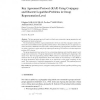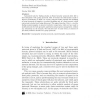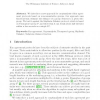275 search results - page 9 / 55 » On The Security of a Group Key Agreement Protocol |
INFORMATICALT
2007
13 years 7 months ago
2007
The key agreement protocol based on infinite non-commutative group presentation and representation levels is proposed. Two simultaneous problems in group representation level are ...
JAR
2006
13 years 7 months ago
2006
Automated tools for finding attacks on flawed security protocols often fail to quately with group protocols. This is because the abstractions made to improve performance on fixed ...
INDOCRYPT
2009
Springer
14 years 2 months ago
2009
Springer
Abstract. Contrary to conventional cryptographic wisdom, the NIST SP 800-56A standard explicitly allows the use of a static key pair in more than one of the key establishment proto...
CCS
1998
ACM
13 years 12 months ago
1998
ACM
Many modern computing environments involve dynamic peer groups. Distributed simulation, multi-user games, conferencing and replicated servers are just a few examples. Given the op...
PKC
2007
Springer
14 years 1 months ago
2007
Springer
Abstract. We introduce a new approach for cryptanalysis of key agreement protocols based on noncommutative groups. Our approach uses functions that estimate the distance of a group...



